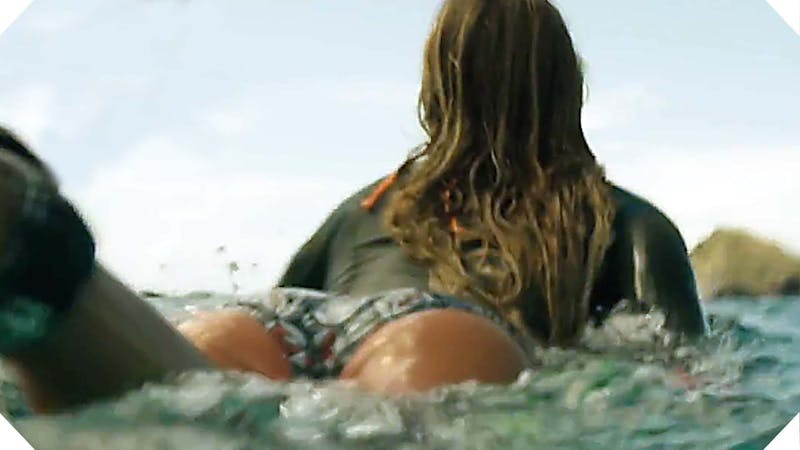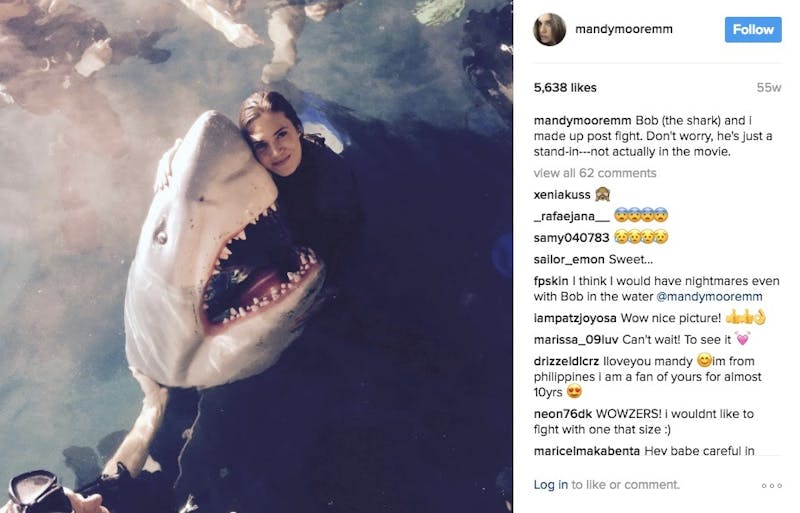Nitrogen narcosis is also known as raptures of the deep (“l’ivresse des grandes profondeurs,” as Jacques Cousteau put it), or the Martini effect. It is a consciousness-altering condition that affects divers at certain depths. While a diver is affected, she may feel euphoric and see things that are not really there. Like nitrogen narcosis, shark movies are great fun but sometimes they are not very good for you.
Two movies came out last year which were both called, at different stages, In the Deep. One was called In the Deep during production but eventually came out as The Shallows. It starred Blake Lively as a lone surfer who gets stranded on a rock while an enormous shark circles her. (The title change makes sense, since the water doesn’t seem very deep in any part of the movie.) The other movie about sharks starred Mandy Moore. Its working title was 47 Meters Down, but it quietly drifted into total obscurity after a DVD-only release under the title In the Deep.
Presumably the production company gave up on 47 Meters Down after The Shallows slaughtered the summer. The two movies are, after all, remarkably similar. In each, a toothsome leading lady on vacation must fight the odds to escape a shark or sharks that wish to eat her. Both movies are set in Mexico. They both feature early scenes of their heroines texting loved ones back home. In both, the text messages show up as little speech bubbles on the screen. Those conversations motivate each leading lady.
47 Meters Down will be re-released in cinemas under its old title because the North American rights were bought from the Weinsteins by Entertainment Studios (there’s no release date yet). I managed to get hold of an old copy—the internet has been mostly scrubbed. Although it’ll probably come to cinemas under a different edit, the movie I saw was an original spin on a tired old genre. And it blew The Shallows far, far out of the water. (To avoid confusion, I’ll refer to each movie by the title that is not In the Deep).
Mandy Moore does not wear a bikini in any scene. By contrast, The Shallows featured numerous close-ups of Lively’s glistening butt, bobbing out of the water like two buoys on a surfboard. There’s nothing wrong with flesh in a horror movie, but The Shallows seemed pitched at 13-year-old boys. The plot pits one girl against one shark; there are no other major characters in The Shallows. Lively is a pleasant screen presence but she is not Laurence Olivier, so the movie was basically a low-rent monologue occasionally interrupted by wet buttocks. The show is stolen from Lively by an injured seagull. (I saw the movie three times anyway.)

47 Meters Down centers on a pair of sisters called Lisa (Moore) and Kate (Claire Holt). In a dreadful cage-diving accident, the sisters get dropped (still in cage) onto the floor of a shark-infested ocean. Since there are two of them and they’re wearing mic’d diving helmets, this movie’s characters are able to have a conversation. They can say things like “How deep do you think it goes?” to each other, before they fall. The movie thus develops themes, instead of relying on survival quest and gratuitous ass-shots for its thrust.
Lisa’s boyfriend has left her, because he got bored. The sisters have gone on this vacation partly to exercise Lisa’s sense of adventure: Kate, who is younger, is already pretty wild. To soothe Lisa’s grief, the girls go out to a local bar where they dance and smile and meet two hot boys. The two boys know of a cage-diving operation, and invite them to go along. It’s only a hundred bucks, they say. Lisa is terrified, but Kate talks her into it. The boys literally lure the girls into a cage. Kate convinces Lisa to get in it by saying that the photos they take will not be the photographs of a boring person. A shark later eats their camera.
The movie’s theme is pressure, both literally and figuratively. Once trapped at the bottom of the sea, Lisa and Kate cannot make a mad dash for the surface because the water pressure will give them the bends. Lisa ends up in the cage in the first place because she bows to social pressure (to impress her ex, to placate her sister). The movie thus extends the pressure question in an interesting way: it is not just about the water or the lover, but the full gamut of social pressures women uniquely face. As a friend, as a sister, as a lover, as a hero, Lisa must survive.
47 Meters Down plays on a vast array of fears: the dark, sharks, running out of air, abandonment, the death of one’s family, being trapped in a cage. Mandy Moore is also a good actor, so the film is legitimately frightening. The movie ends with a stonkingly good twist. The Shallows took the summer of 2016, but let’s hope that Mandy Moore has her day in the sun this year.

A third shark movie came out in 2016. USS Indianapolis: Men of Courage starred Nicolas Cage and told the true story of the ship sunk by the Japanese during World War II as it made its way home from delivering parts for one of the atom bombs. Its mission was so top-secret that Navy command did not know it was out there, so they did not send help until a plane spotted the human flotsam four days later. The grouchy old sailor of Jaws, you will recall, was a survivor of that tragedy. Over a thousand sailors shipped out and only around 300 survived.
Like 47 Meters Down, the Indianapolis movie is radically unlike The Shallows. Blake Lively’s movie features only Lively; USS Indianapolis: Men of Courage technically has a cast of a thousand. But it has certain features in common with The Shallows. The movie is rife with absurd foreshadowing, as when a sailor rolls snake eyes in a dice game a split second before the first torpedo hits. One sailor keeps a white dove for luck, but a character who cannot swim points out it is a pigeon (wrong tail length). As the ship sinks, a copy of National Geographic with a prominent shark illustration on its cover floats past a terrified sailor.
USS Indianapolis: Men of Courage is a deeply cheesy movie pinned to a mannequin-like performance from Cage. There are still survivors of the USS Indianapolis disaster around today: this film is truly an insult to their suffering. Though it features a thousand men instead of one lithe girl, USS Indianapolis: Men of Courage echoes The Shallows in that it flimsily bolts human relationships onto a violent spectacle. In Indianapolis, there’s a girl at home; in The Shallows, there’s a dead mom.
47 Meters Down knows that the viewer can only be truly frightened once they are in a state we might call the rapture of the deep. The endangered heroes of a truly excellent survival movie must be sympathetic, well-rounded, alive. If the characters do not live, we do not care if they die. The greatest movie in this respect is 2003’s Open Water—the only shark flick that will make you cry.
All the movies mentioned here at least share a commitment to innovatively freaky moviemaking. There are some abominable clunkers in the shark movie canon, but any film that can get away from the tired cliche of monster-terrorizing-boat deserves praise. We can but hope that the future of filmmaking contains more sharks, if they encourage forward thinking. Rapture is not a logical state of mind: it is more like a state of pathological sublimity. As such, the raptures of the deep remain a lofty challenge for any filmmaker. Once it makes its big debut, 47 Meters Down will be a new bar.
